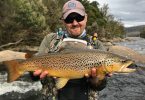It was during a hatch of Chironomids that I noticed the action in this buzzer which was quite amazing considering that it was just sat there in the surface film, "Static, Flick, Pause, Flick, Flick, Static". I tie by standard ‘Decent’ flies, tongue in cheek, but one that comes to life, surely not!!
Here is the scenario, I had pulled ten yards of line in through the rings and put the rod down to pick up a box of flies from my bag in the well of the boat, the cast was still in the water in the Oily calm, I was about to change the fly in an attempt to deceive the wild trout of Lough Corrib when Frank Reilly pointed out that the fly was coming to life. I was sat there transfixed to the spot my mind racing and fighting with itself for an explanation to what was happening. Call me slow or even something else if you wish, it wasn’t the buzzer at all it was the nylon leader straightening out the twist in itself, I’ll explain later.

Suspender buzzers are popular patterns to use in conditions of Oily calm with the fish active on the emerging nymphs and I am a fan of these patterns, they are very effective, given the right conditions, the use of ethafoam cut in a strip folded and refolded over itself instead of the polystyrene bead encapsulated in a Nylon stocking appears to be hardier in the Trout’s teeth and last a little longer before disintegrating, I had tied some up using various body materials in case of the Oily calm conditions.
One can usually see the ethafoam in the surface film at quite a distance but to enhance this I had left a piece of ethafoam overlapping the hook eye and trimmed it to a fine point just as an added sight marker so I could easily pick it out at a further distance on the water, I hadn’t realised that the Curved shank hook together with this trimmed ethafoam pole would actually spin when pulled through the water thus creating the twist in the nylon leader, naturally when you stopped pulling the nylon leader would correct itself and cause the buzzer pattern to flick round whilst static in the surface film, giving it that added hint of reality, to fool an interested Trout.
A little experimentation followed with three or four quick pulls of 18-24 inches being enough to load the buzzer to give two or three flicks whilst static at the end of the line pulling action, this method proved itself when a decent Trout of 2lb engulfed the offering, the buzzer was cast yards in front of the area of activity and three or four sharp pulls at the line created the buzzer to spin, twisting the nylon leader in the process, all stop and wait, flick, flick, as the leader corrects itself, and slurp, ring in the film, tighten, fish on!.
Surface disturbance creates interest in fish that are actively feeding, watch closely in a hatch as the insect struggles to free itself from its pupal shuck, effectively you will be copying closer what nature is throwing at us by using this method.
You need to use a medium stiff nylon as the stiffer nylons do not twist so well and the softer nylons will not correct themselves effectively, and I recommend to only using the one fly on a ten foot level leader.
This method has proved itself on many of the small stillwaters that I visit where the stocked Rainbows really do love them. Some boat anglers fishing a team of wets broadside on will have experienced frustrating following fish which follow the fly on the retrieve and turn away at the last minute, this Method works, change your cast and put on this suspender buzzer the Interested following fish will smash into the static buzzer as soon as it starts to flick in the surface film.
To dress the "GH Flick Buzzer" I use a Tiemco 2487 size 10 or 12 or a Mustad 80250. Place the hook in the vice and run your tying thread (Colour to match Body Colour) from near the eye to around the apex of the hook bend to the point where you want to tie in your breather filaments, White Marabou or White Rabbit fur tied in and trimmed, pinch off closely to leave sparse. Tie in your chosen rib and form a dubbing loop, wax and tease in your chosen body material, spin and wind around the body to the thorax area, trap in with a half hitch but do not trim at this stage, wind on your rib to trap the body into place and trim the surplus rib. Cut a strip of ethafoam width and colour to suit pattern and size, sufficient to hold the hook up. Tie this in to lie out over the hook eye trapping in about 1/8"of the ethafoam, now bring the dubbing mix over to cover and tie in trimming the surplus, fold the ethafoam over the 1/8" section of thorax and take your tying thread around twice, do not pull the ethafoam too tight or the tying thread, or it may slice through the ethafoam, fold the ethafoam back over the top of the first layer, again be careful not to expel the air trapped within by over tightening, tie this down near the eye with two or three turns of the tying thread. Lift the remaining piece of ethafoam up and wind the tying thread, building a head against the eye of the hook, whip finish. Trim the ethafoam to a sharp point and varnish the head.
Let me know how you get on with this method!
Gwilym Hughes (APGAI)
You can find a wealth of interesting information on Gwilym’s background, along with details on his tutorial videos and tutoring services at: http://www.gwilymhughes.com
Got a flyfishing question you’d like to ask Gwilym? Please email us and we’ll pass it on.








